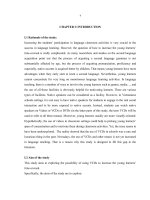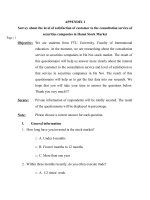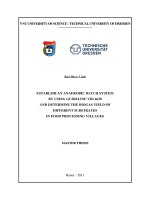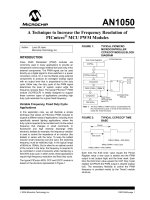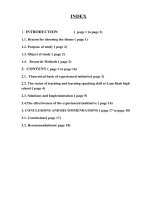Using a vocabulary website to increase the vocabulary size of IT workers in hanoi
Bạn đang xem bản rút gọn của tài liệu. Xem và tải ngay bản đầy đủ của tài liệu tại đây (1.02 MB, 76 trang )
VIETNAM NATIONAL UNIVERSITY, HANOI
UNIVERSITY OF LANGUAGES AND INTERNATIONAL STUDIES
FACULTY OF POST- GRADUATE STUDIES
NGUYỄN THỊ LƯƠNG
USING A VOCABULARY WEBSITE TO INCREASE
THE VOCABULARY SIZE OF IT WORKERS IN HANOI
(Việc sử dụng trang web từ vựng để gia tăng vốn từ của nhân viên IT tại Hà Nội)
M.A. MINOR PROGRAMME THESIS
Field: English Teaching Methodology
Code: 8140231.01
Hanoi, May 2019
VIETNAM NATIONAL UNIVERSITY, HANOI
UNIVERSITY OF LANGUAGES AND INTERNATIONAL STUDIES
FACULTY OF POST- GRADUATE STUDIES
NGUYỄN THỊ LƯƠNG
USING A VOCABULARY WEBSITE TO INCREASE
THE VOCABULARY SIZE OF IT WORKERS IN HANOI
(Việc sử dụng trang web từ vựng để gia tăng vốn từ của nhân viên IT tại Hà Nội)
M.A. MINOR PROGRAMME THESIS
Field: English Teaching Methodology
Code: 8140231.01
Supervisor: Trần Thị Thu Hiền, PhD
Hanoi, May 2019
DECLARATION
I hereby declare that the thesis entitled “using a vocabulary website to increase the
vocabulary size of IT workers in Hanoi” is my own work and effort and that it has
not been submitted to any other university or institution wholly or partially.
Hanoi, May 2019
Nguyễn Thị Lương
i
ACKNOWLEDGEMENTS
This research has been accomplished with the support and encouragement of
many people. Hence, I hereby would like to express my appreciation to all of them.
Firstly, I would like to express my sincere thanks to my supervisor, Trần Thị
Thu Hiền, PhD for her great assistance and guidance throughout my research.
Secondly, I also like to show my profound gratitude to the Faculty of PostGraduate Studies for the valuable lectures and precious support without which I would
be unable to overcome difficulties during the time my research was carried out.
Besides, I would like to give my whole-hearted thanks to my students in my
tutor class for their enthusiastic participation in my research. Without their help, I
would not have been able to complete this paper.
Last but not least, I owe a great debt of gratitude to my beloved family
whose support and encouragement have always been a great deal of motivation that
has helped me to overcome all problems to complete my thesis.
Nguyễn Thị Lương
ii
LIST OF ABBREVIATIONS
AR:
Action research
CARE:
(Information quality categories in) contents, accessibility, representation
and education
EFL:
English as foreign language
ICT:
Information communication technology
IQ:
Information quality
L1:
First language
L2:
Second language
URL:
Uniform Resource Locator
WFE:
Website for education
iii
TABLE OF CONTENTS
DECLARATION ........................................................................................................ i
ACKNOWLEDGEMENTS .................................................................................... iii
LIST OF ABBREVIATIONS................................................................................. iii
LIST OF TABLES .................................................................................................. vi
ABSTRACT ............................................................................................................ vii
CHAPTER 1. INTRODUCTION ...........................................................................1
1.1. Rationale of the study..........................................................................................1
1.2. Aims and objectives of the study .........................................................................3
1.3. Research questions ...............................................................................................3
1.4. Scope of the study ................................................................................................3
1.5. Significance of the study ......................................................................................4
1.6. Methods of the study ............................................................................................4
1.7. Organization of the thesis.....................................................................................5
CHAPTER 2. LITERATURE REVIEW ................................................................6
2.1. Vocabulary in Foreign Language Acquisition .....................................................6
2.1.1. Definition of vocabulary ...................................................................................6
2.1.2. Principles of vocabulary learning .....................................................................7
2.1.3. Difficulties in learning vocabulary .................................................................10
2.1.4. Approaches to teaching and learning vocabulary ...........................................11
2.2. ICT application in vocabulary acquisition .........................................................16
2.2.1. Definition if ICT .............................................................................................16
2.2.2. Role of ICT in education .................................................................................16
2.2.3. Potential use of ICT in vocabulary learning ...................................................17
2.3. Vocabulary websites ..........................................................................................18
2.3.1. Definition of vocabulary websites ..................................................................18
2.3.2. Evaluation criteria for vocabulary websites ....................................................18
2.4. Previous studies ..................................................................................................22
2.4.1. Oversea studies................................................................................................22
2.4.2. Vietnamese studies ..........................................................................................24
iv
2.5. Chapter summary ...............................................................................................26
CHAPTER 3. METHODOLOGY .........................................................................27
3.1. Context of the study ...........................................................................................27
3.2. Action research ...................................................................................................27
3.2.1. Definition ........................................................................................................27
3.2.2. Rationale of uing AR ......................................................................................32
3.3. Participants of the study .....................................................................................33
3.4. Data collection instruments and procedure........................................................34
3.4.1 The pre-test and post-test .................................................................................34
3.4.2 The questionnaire ............................................................................................35
3.5. The research stages ............................................................................................35
3.5.1 Identifying the problem ....................................................................................35
3.5.2. Intervention .....................................................................................................36
3.5.3. Post-intervention stage ....................................................................................36
CHAPTER 4. FINDINGS AND DISCUSSION ...................................................38
4.1. The progress in increasing students’ vocabulary by using the vocabulary websites ...38
4.1.1. Result of the pre-test .......................................................................................38
4.1.2. Result of the post-test ......................................................................................38
4.1.3. Result of the questionnaire..............................................................................40
4.2. Discussion ..........................................................................................................41
CHAPTER 5. CONCLUSION ...............................................................................43
REFERENCES ........................................................................................................47
APPENDICES ........................................................................................................... I
APPENDIX A: PRE-TEST ........................................................................................ I
APPENDIX B: POST TEST .................................................................................... IV
APPENDIX C: QUESTIONNAIRE ........................................................................ VI
APPENDIX D: Word List ...................................................................................... VII
v
LIST OF TABLES
Table 4.1. The vocabulary pre-test ............................................................................38
Table 4.2. The vocabulary post – test result .............................................................39
Table 4.3. The results of students’ questionnaire answers ........................................40
LIST OF FIGURES
Figure 3.1. Types of research methodology ..............................................................27
Figure 3.2. Ernest Stringer’s AR model (in Mills, G 2003, p.18) ............................29
Figure 3.3 Detailed AR model .................................................................................31
Chart 4.1. The overall mean score in pre-test and post-test ......................................39
vi
ABSTRACT
This study investigated the potential effect of using a vocabulary website on
increasing vocabulary size. The research aimed to figure out whether the use of
vocabulary instruction website could help widen IT students’ vocabulary and to
identify students’ attitude towards using the website instead of their traditional way.
In order to accomplish these purposes, 15 students who are IT workers in one of my
tutor classes in Hanoi were selected to participate in the study. All the students
learned to take TOEIC exam to meet their company requirement which is 700
TOEIC and they came from the same linguistic background. To achieve this target
in a short period of time, the students focus mainly on increasing the passive
vocabulary. Three data collection instruments were employed, namely pre-test/posttests and questionnaire. After one month, the post-test and a questionnaire were
administered. The analysis of the data collected revealed that the students made
encouraging progress in boosting vocabulary size by using the vocabulary website;
besides, according to the result of the questionnaire these IT workers were more
motivated to learn vocabulary than they usually do.
Key words: vocabulary learning, vocabulary increase, information
communication technology (ICT)
vii
CHAPTER 1. INTRODUCTION
1.1. Rationale of the study
Undoubtedly, English has become the global language which is used widely
all over the world, at school and for entertainment and tourism and especially at
work. Among many other elements to master before one can have communicative
competence at English, vocabulary plays one of the most significant roles. “One
thing that students, teachers, materials writers, and researchers can all agree upon is
that learning vocabulary is
an
essential
part
of
mastering
a second
language. However, the best means of achieving good vocabulary learning is still
unclear, partly because it depends on a wide variety of factors” (Schmitt, 2008).
Wikins argued (1972) that “Without grammar very little can be conveyed, without
vocabulary nothing can be conveyed.” Oxford (1990a) pointed out that language
learners typically have significant difficulty remembering large vocabularies. Over
the past recent years, numerous studies have examined English learning, and most
emphasized the importance of vocabulary learning to English learning (DeCarrio,
2001). An excellent vocabulary is beneficial to inferring meaning from English
sentences (Harmon, 1998, 2002; Rupley, Logan & Nichols, 1999). Nonetheless,
countless learners who learn English as a second language have always found
learning vocabulary frequently as a challenging and boring task to do because they
are too busy with their work, social relationships and family; not to mention that
most of them cannot memorize words as well as young learners, especially with
long or infrequently used words. In addition, learning vocabulary is supposed to do
by themselves at home, and then it requires lots of autonomy and self-motivation.
Last but not least, forgetting learned vocabulary is another serious problem during
learning English vocabulary. Forgetting is the loss of information over time. People
typically recall information better just after learning than after a long delay.
Ebbinghaus (1985), based on experimental result, proposed the forgetting curve.
However, memory strategies help learners to overcome forgetting. Memory
1
strategies enable learners to store and retrieve information when needed. Oxford
(1990a) subdivided memory strategies into following four types creating mental
linkages; applying images and sounds; reviewing; and, employing actions.
However, as a teacher, the researcher often sees the lack of strategies students in
learning vocabulary.
While English has become the most important second language in nonEnglish speaking countries, developing modern assistive learning forms or tools that
support effective English learning has been a crucial issue in language English
education field. Besides work books and other written resources, technology
integrated language teaching provides a lot of materials for language learners as
well. Websites might be regarded as online teaching tools which can be very
effective resources both for learners and teachers. While teachers cannot spend a
sufficient amount of time to teach vocabulary regularly at class, making use of some
vocabulary website equipped with lots of organized learning tools can be a wise
choice. Using some particular vocabulary sites to learn new words, teachers can
recommend students with appropriate range of words and can keep track of
student’s vocabulary size as well as be able design some more relevant activities or
tasks at class. In other words, these websites can work as an efficient teaching and
learning tool. Besides, we are living in a time of high technology that almost every
adult owns at least one smart mobile phone or tablet which is easily accessible to
the Internet, students feel free to learn at their convenience, which is perfect for
busy workers such as IT employees.
The students that the researcher teaches are IT workers who are learning
English for TOEIC exam. In a regular TOEIC test, there are two skills being tested,
namely listening and reading; besides, this is a multiple-choice test then students
who learn for the test rather than for a direct communicative purposes.
Last but not least, the website chosen for the research on is https//:
quizlet.com. Its reputation has been stated with over fifty million users active every
month. It is creatively designed for a variety of levels and subjects. The website
2
quizlet.com let the students learn the words they choose by inputting them into the
site and it will create activities, tests and games with those words. Whereas,
traditionally, students often find it uninteresting to learn vocabulary with flashcards
or repeat the word in writing or speaking, but with these websites they can learn, do
test and play games. Words are presented with picture and spoken by native
speaker. The website also marks the students on each words they learn and give
them more tasks for the words they tend to miss. With such varied qualities,
students are more likely to find it interesting to learn vocabulary.
For such those reason, the researcher has chosen this matter to conduct the study.
1.2. Aims and objectives of the study
This research aims at using a vocabulary website to encourage adult students
who work for an IT company in order to increase their vocabulary size. In order to
achieve the aim, the researcher points out some main objectives as below:
-
Investigating to what extent using the vocabulary website suggested by the
researcher increases the students’ vocabulary size.
-
Identifying the students’ attitude towards the use of vocabulary websites for
improving their vocabulary size
1.3. Research questions
In a nutshell, the researcher is going to answer two following questions:
1.
To what extent does using a vocabulary website improve the IT workers’
vocabulary size?
2.
What is the attitude of the IT workers towards the use of vocabulary websites
for improving vocabulary size?
1.4. Scope of the study
There are many aspects of learning vocabulary to be investigated; however,
this study is narrowed down to identify the effect of using a vocabulary website to
increase the number of words and mainly focus on vocabulary retention in shortterm memory in order that adult students of a small-scale class can make use of it
for a specific target (the TOEIC test in this case). Therefore, the use and
3
improvement of the vocabulary size for other purposes like communication would
not be discussed in this study.
1.5. Significance of the study
Needless to say how important the role that vocabulary learning and teaching
plays is to language learners, teachers and linguistics; this study might make be
taken advantage in the following aspects.
In term of theory, the study would make some certain contribution to the
field of vocabulary teaching and learning as well as information technology
application into language learning. The whole study based on a great number of
theories of knowledge related to vocabulary learning and teaching from renowned
linguistics all over the world and several studies closely related to the field that this
research investigates.
For practical use, the study, if proved effective, will be a good reference to
English learners and teachers in the similar context. Learning vocabulary of a
language has always been considered as one of the hardest parts in learning a new
language, as it is rather boring but time-consuming. Learners are supposed to
memorize a massive number of words to master the language. Therefore, if this
website proves to be an effective way of learning vocabulary, language learners can
make extensive use of. Moreover, although the study is conducted in a small scale
class, once being completed, it may bring advantages to numerous teachers.
Optimistically, the teachers will take this research as a helpful consultant for
teaching English vocabulary to learners.
1.6. Methods of the study
In order to achieve the aims and objectives afore mentioned, the study
employs a mix-method approach. In this research, both qualitative and quantitative
methods are employed.
Firstly, the quantitative method is used to analyze the data collected from the
pre-tests and post-tests. Then, conclusions are drawn from the results using
inferential statistics. In the next step of the research, the qualitative method has been
4
applied so that the data collected from the survey questionnaire can show out the
learners’ attitudes towards the use of the vocabulary website in their vocabulary
development.
Importantly, action research plays a crucial role in this thesis as through the
stages of the research conducted by the researchers, the learner’s vocabulary
development and their attitudes towards the use of the website have been identified.
1.7. Organization of the thesis
The minor thesis is composed of following parts and chapters:
CHAPTER 1. INTRODUCTION
This part presents rationale of the study, aims and objectives, research questions,
the scope, the significance, the research methods and organization of the study.
CHAPTER 2. LITERATURE REVIEW
This chapter presents the theoretical backgrounds and previous research related
to the topic of the study.
CHAPTER 3. METHODOLOGY
This chapter involves the information about the setting of the study, the
participants, instruments for collecting data and data collection and analysis
procedures.
CHAPTER 4. FINDINGS AND DISCUSSION
The findings of the tests, questionnaire and observations are presented in this
chapter. Issues related to the topic are then discussed to help hightlight the
research findings.
CHAPTER 5. CONCLUSION
This part summarizes major findings, provides recommendations, shows
limitations of the study and suggests topic for further studies.
5
CHAPTER 2. LITERATURE REVIEW
2.1. Vocabulary in Foreign Language Acquisition
2.1.1. Definition of vocabulary
There are several definitions of vocabulary in the literature review. The
central idea of these definitions may be summed up by Lewis (1993) who identified
vocabulary as “individual words, or full sentences – institutionalized utterances –
that convey fixed social or pragmatic meaning within a given community”. So from
single words like “play” to multiple word items such as greenhouse and father –inlaw can be identified as vocabulary as long as it expresses a single idea. Another
definition sharing this idea is “a set of lexemes, including single words, compound
words and idioms” (Richard, Platt &, 1992) or as defined by Ur (1996 :60):
“vocabulary can be defined, roughly, as the words we teach in the foreign language.
However, a new item of vocabulary may be more than a single word”. Likewise,
McCarthy (1990) argues that multi-word units including idioms and phrasal verbs
should clearly be treated as single lexical items since their meaning are partly
identified by their fixedness. The second idea would be the definition of vocabulary
as its importance in a language. Pyles and Algeo (1970) stated when most it of us
think about language we think first about words. It is true that the vocabulary is the
focus of language. It is in words that sounds and meanings interlock to allow us to
communicate with one another, and it is words that we arrange together to make
sentences, conversation and discourse of all kinds. As another researcher supporting
this idea, Wilkins (1972) also emphasized this “without grammar, very little can be
conveyed, without vocabulary nothing conveyed”. Therefore, vocabulary teaching
and learning has long been an area of concern to linguists. To what extent a words is
considered known to learners is another question. Nation (2001) once stated
knowing a word means knowing at least it forms, its meaning and its basic usage.
Besides, there are many factors affecting the learning difficulty of words.
6
Overviews are given by Nation (1990, ch.3), Laufer (1997), and Rodgers (1969).
Nowadays, no one might deny the significant role of vocabulary in language
teaching and learning.
Last but not least, what is meant to see the overall task of vocabulary
learning is through the distinction between knowing a word and using a word. In
other words, the purpose of vocabulary learning should include both remembering
words and the ability to use them automatically in a wide range of language
contexts when the need arises (McCarthy, 1984). In fact, evidence suggests that the
knowledge aspect (both breadth and depth) requires more conscious and explicit
learning mechanisms whereas the skill aspect involves mostly implicit learning and
memory (Ellis, 1994). Vocabulary learning strategies, therefore, should include
strategies for “using” as well as “knowing” a word. Another way to view
vocabulary learning is to see it as a process of related sub-tasks. When learners first
encounter a new word, they might guess its meaning and usage from available
clues. Some learners might proceed to look it up in the dictionary. Others might
take down notes along the margins, between the lines, or on separate vocabulary
notebooks. Some learners will repeat the new word a number of times until they are
comfortable with it. Others will go beyond simple rote repetition to commit the
word to memory. Some would even try to use the word actively. Each of these task
stages demands metacognitive judgment, choice, and deployment of cognitive
strategies for vocabulary learning. And each strategy a learner uses will determine
to a large extent how and how well a new word is learned.
2.1.2. Principles of vocabulary learning
However, many theories about vocabulary learning process were written, it
still remains the matter of memory. Thus, there are several general principles for
successful teaching, which are valid for any method. According to Wallace (1988),
the principles are:
Aim – what is to be taught, which words, how many
Need -
target vocabulary should respond student’s real needs and
interests
7
Frequent exposure and repetition
Meaningful presentation – clear and unambiguous denotation or
Reference should be assured
Estimates of vocabulary size based on an individual’s knowledge of words
sampled from a dictionary or frequency accounts of words found in the running text
have continued to be the main source of information about vocabulary size (Lorge
and Chall, 1963)
Unlike the learning of grammar, which is essentially a rule based system;
vocabulary is mainly a question of accumulating individual item. The general rule
seems to be the question of memory during the process of learning and teaching
vocabulary. Thornburry (2002) distinguished memory into three systems namely
short-term memory, long-term memory and working memory. Short-term store is
the brain capacity to hold a limited number of item of information for a short period
of time. It is kind of memory that is involved in repeating a word that you have just
heard your teacher modeling. But successful vocabulary learning involves more
than holding words for such short period of time. To integrate words into long-term
memory they need to be subjected to different kinds of operations on them. It means
the information is manipulated via the senses from external sources and/ or
downloaded from the long-term memory. Material remains in the working memory
for about twenty second. The existence of articulator loop enables this new material
working. It works a bit like audiotape going round around again. It reassures the
short-term store to be refreshed. The ability to hold a word in working memory is a
good predictor of language learning aptitude. The better ability to hold words in
working memory the smoother process of learning foreign languages is. Long-term
memory can be seen as permanent content, this kind of memory has an enormous
capacity and its contents are durable over time. However, to ensure moving new
materials into permanent long-term memory requires number of principles to be
followed, described by Thornbury (2002):
• Repetition-repetition of encounters with a word is very important, useful
8
and effective. If the word is met several times over space interval during
reading activities, students have a very good chance to remember it for a
long time.
• Retrieval: another kind of repetition. Activities, which require retrieval,
such as using the new items in written tasks, help students to be able to recall
it again in the future.
• Spacing it is useful to split memory work over a period of time rather than
to mass it together in a single block.
• Pacing-to respect different learning styles and pace, students should be
ideally given the opportunity to do memory work individually.
• Use-putting words to use, prefer ably in an interesting way, is the best way
of ensuring they are added to long-term memory. This is so called “Use it or
lose it” principle.
• Cognitive depth-the more decisions students make about the word and the
more cognitively demanding these decisions are, the better the word is
remembered.
• Personal-organizing personalization significantly increased the probability
that students will remember new items. It is achieved mainly through
conversation and role playing activities.
• Imaging-easily visualized words are better memorable than those that do
not evoke with any pictures. Even abstract words can be associated with
some mental image.
• Mnemonics – tricks to help retrieve items or rules that are stored in
memory. The best kinds of mnemonics are visuals and keyword techniques.
• Motivation strong motivation itself does not ensure that words will be
remembered. Even unmotivated students remember words if they have to
face appropriate tasks.
• Attention it is not possible to improve vocabulary without a certain degree
of conscious attention.
9
More importantly, it should be noted that 5-16 exposures are needed in order
to learn a word from context (Nation: 1990). Meara (1997) suggested a 0.01
hypothesis (1 uptake every 100 exposures) for L2 learners, arguing that these
learners are normally unable to be exposed to large quantities of text. A more recent
study (Horst, Cobb, & Meara, 1998), which featured low intermediate EFL learners
reading a 109- page book over a ten-day period, obtained a 20% pick-up rate. They
also observed than words that were repeated less. Results so far seem to vary
considerably. However, researchers do seem to have come to the conclusion that the
number of exposures needed for the mastery of a new word hinges on many other
factors such as the salience of the word in context (Brown, 1993), the richness of
contextual clues, the learner’s interest and the size and quality of his/her existing
repertoire of vocabulary (Laufer & Hadar, 1997; Nation & Hwang, 1995).
Encouraging findings on this issue can be found in the literature. Crothers
and Suppes (1967) discovered that almost all of their participants remembered all
108 Russian – English word pairs after 7 repetitions, and about 80% of 216 word
pairs were learned by most participants after 6 repetitions. Similarly, Lado, Baldwin
and Lobo (1976) presented their intermediate level college students of Spanish with
a list of 100 words, and found that only one exposure sufficed for an average of
95% recognition and 65% recall. In general, results on this issue show that, if
remembering word pairs is the aim, a surprising amount can be learned within a
relatively short time (Thorndike, 1908; Webb, 1962), and not many repetitions are
needed before the L2-L1 word pairs can be remembered.
2.1.3. Difficulties in learning vocabulary
Word forms may differ in difficulty for coding and storing depending on
the learner’s prior phonotactic knowledge. When a L2 learner embarks on the
learning of an entirely new language, morphonologically and phonetically unrelated
to any language already known to him or her, he or she may experience great
difficulties in storing isolated as well as clustered sounds or letters. Learning the
first 15 content words of a new L2 language may take the beginning learner several
10
hours. However, three months of daily study later, he or she may easily add another
hundred new words to his or her medium-sized vocabulary in one hour simply
because, by that time, letters and sounds are no longer encoded as single units but in
now familiar chunks of phonemes, morphemes, syllables and prosodic patterns. The
learner now implicitly knows which sequences and combination of elements are
legal and which ones are not (Ellis & Beaton, 1993). Several studies have shown
that repetition of L2 word forms in the form of avert or silent articulation, briefly
held in working memory (Baddeley, 1997) promotes their long-term retention.
Thus, the evidence of all these studies suggests that the codability and hence the
memorability of the forms of new words is contingent upon the learner’s prior
familiarity with various aspects of the linguistic system.
The second subjective, knowledge-dependent factor affecting a word’s
memorability is the arbitrariness of the form-meaning link, i.e., arbitrariness in
terms of existing lexical knowledge. If a new word appears to the learner as having
a form unrelated to its meaning it will need more attention and mental elaboration
than if it has a transparent appearance. For example, suppose someone was trying to
coin a new word in the English language referring to a door made of opaque glass.
Suppose, furthermore, this person considered three alternatives: “fogdoor”, “rog”
and “dorricor”, then clearly for people already familiar with the words “fog”,
“door” and “corridor”, “fogdoor”, being a non-arbitrary and transparent word form,
would be easy to learn, while “rog” and “dorricor” would be more difficult to learn,
“rog” being a fully arbitrary word form, and “dorricor” likely to be confused with
“corridor”: being what Laufer (1988,1991) has called a “synform”, when lexical
forms similar in their phonological, graphic and/or morphological features, prone to
causing lexical confusion in learners of English.
2.1.4. Approaches to teaching and learning vocabulary
2.1.4.1. Incidental and intentional vocabulary learning
Incidental learning is not planned by either the instructor or the student but
occurs as a ‘by-product’ of another activity; intentional learning is regarded as
11
being deliberately intended by the teacher or the students (Nation, 1990). In terms
of learning vocabulary, incidental learning requires learners to acquire vocabulary
through reading, and, although some tasks or exercises might be imposed on them,
the tasks or the exercises may not be directly related to learning vocabulary. In
contrast, intentional learning requires learners to memorize the meaning of the
target words via various conscious vocabulary-learning strategies.
Much research (Krashen, 1993; Laufer, 2009; Nagy, Herman, & Anderson, 1985)
has shown that the successful achievement of incidental vocabulary learning could
manifest through extensive reading. However, some researchers (Nation, 2001; Van
Zeeland & Schmitt, 2012; Waring & Nation, 2004) have questioned the
effectiveness of extensive reading on incidental vocabulary learning. For instance,
Waring and Nation (2004) argued that extensive reading could not provide enough
opportunities to learn vocabulary proficiently within a restricted time. Instead, they
proposed that explicit vocabulary learning, wherein attention is paid to linguistic
forms, is more effective in learning vocabulary. Other researchers (Nation, 2001;
Van Zeeland & Schmitt, 2012) have also pointed out that successful guessing in
context requires knowing 95% of the words. In some research, although incidental
vocabulary learning did occur, the effects were very small and cumulative. For
example, Saragi, Nation and Meister (1978) argued that, for the words to be better
engraved in learners’ mind, at least ten instances of exposure to target words were
necessary. Waring and Takaki (2003) proposed that almost one half of the
vocabulary learned incidentally through reading was lost after three months, and the
learners needed at least eight instances to achieve a 50% chance of recognizing a
word after three months. Moreover, Teng (2014a) also proposed that ten instances
were needed for EFL learners in China to master the form and meaning of target
words incidentally. Hence, the extant research questions the effectiveness of
extensive reading on incidental learning for L2 or EFL learners. However, this
research shares a common point in that learners could deepen the understanding of
previously encountered words, thus making it easier to master the words when they
12
have more exposure to the words through extensive reading. Therefore, according to
the mentioned research, learning from extensive reading. Therefore, according to
the mentioned research, learning from extensive reading is worthwhile. Indeed, as
stated in Nation (2008), extensive reading is, by far, one of the most essential
vocabulary learning strategies and an indispensable part of any vocabulary learning
program. In addition to this, the research on incidental learning sheds light on
understanding the process of acquiring words.
However, focusing solely on incidental vocabulary learning is not sufficient
(Nation, 2001). Consequently some researchers (Pellicer-Sanchez & Schimitt, 2010;
Pigada & Schmitt,2006) have recommended a learning method that combines
intentional and incidental learning, arguing that, although extensive reading does
contribute to the incidental learning of vocabulary, a supplementary regime with
explicit vocabulary-enhancing exercises yields more vocabulary gains. The current
study, with an aim to measure the growth of vocabulary knowledge for EFL
learners through extensive reading, employs two different groups: a control group
(CG) receiving instruction in extensive reading only, and an experimental group
(EG) using a combined method of incidental learning and intentional learning; e.g.,
they received extensive reading plus pushed-output activities of learning
vocabulary.
2.1.4.2. Grammar-translation method
Grammar-translation method of foreign language teaching is one of the
most traditional methods, dating back to the late nineteenth and early twentieth
century. It was originally used to each “dead” languages (and literatures) such as
Latin and Greek (Thuleen, 1996). However, conscious learning of grammar is no
longer the leading strategy in language educating area. The principle characteristic
of the grammar-translation method is a focus on learning the grammar rules and
their application in translating from one language to the other. Most of the teaching
is provided in students’first language. Vocabulary is presented mainly through
direct translation from the native language and memorization, using bilingual
13
wordlist:
e.g. accountant – kế toán
aiport – sân bay
The basic unit of teaching process is a sentence. Students spend most of
the lesson time completing grammar exercises where the main emphasis is laid on
the accuracy and following given structure. The grammar is presented
systematically in students’ native language and practiced through translation from
one language to the other, e.g.
The woman is sitting by the window. – Người phụ nữ đang ngồi gần cửa sổ
Bạn có thể đưa tôi ra sân bay được không. – Can you take me to the airport?
In regard to language skills, reading and writing are distinctively
preferred to speaking and listening. Little time is spent on oral practice and students
do not have enough opportunities to produce their own sentences.
Krashen (1987) analyzed linguistic output of students from grammar translation
class. He noticed the fact that many students make errors in rules that are easy to
describe, which means that this technique cannot lead to acquisition. He also
emphasizes the importance in balance between grammatical accuracy and
communication. Though utilizing grammar rules raise student’s correctness, when
speaking they incline to have a hesitant style that is often difficult to listen to. They
plan their utterance while their conversational partner is talking. Their output maybe
accurate, but they all too often do not pay enough attention to what the other person
is saying. Students often have difficulties “relating” to the language, because the
classroom experience keeps them from personalizing in or developing their own
style. Grammar translation method should be tempered with other approaches to
create a more flexible and conducive methodology. Thuleen, in his website article
criticizes the harmful effect on students’ interest: “The worst effect of this method is
on students’ motivation. Because (s)he cannot succeed leads to frustration and lack
of confidence in language usage. On the other hand, for students who respond well
to rules, structure and correction, the grammar translation method can provide a
14
challenging and even appealing classroom environment” stated Thuleen (1996). The
list of linguistic attitudes to grammar translation method could be finished by
Barnhouse (1981): “In English teaching dominated by the grammar translation
method accuracy is emphasized more than fluency. Students in such classroom are
extremely particular about linguistic details. They never feed satisfied with their
language productions until the correct answers are provided. They are keenly
interested in the exact words, have a low tolerance of ambiguity, and tend to focus
on discrete grammar points and specific syntactic constructions”
The role of translation is emphasized through this method as Harmer
(1993) “Translation seems to be a useful tool if used sparingly, but t should be used
with caution” If teachers rely on the use of translation to excess, students are losing
some of the essential spirit of being in a language learning classroom. This often
causes listening skills decline. Furthermore, Harmer points to the difficulties of
translation, which requires an efficient speaker of both languages to translate well.
Additionally, according to Harmer, sometimes it is worth giving the mother tongue
equivalent rather than to spending valuable time trying to define or show the
meaning.
Considering the aim of this method we must admit a great deal of
grammar translation method for generations of people educated in such way,
particularly in the study. The students in the research learn to take TOEIC test
which focus on listening and reading multiple choice questions. In addition to this,
the students use English at work mainly reading some instructions in English. To
conclude, it would not be fair to condemn it for being old fashioned and worthless. On
the other side, it would be of great value to the students with such particular purpose in
learning as shown in the experiment later; especially for influencing their motivation
and their linguistic competence in term of increasing their vocabulary size.
15
2.2. ICT application in vocabulary acquisition
2.2.1. Definition if ICT
Information and communication technology (ICT) is referred to as the
varied collection of technological gear and resources which are made use of to
communicate. They are also made use of to generate, distribute, collect and
administer information. ICT has incredibly changed many aspects of the life we
live. ICT consists of software, hardware, network and media for collecting,
processing, storage, transmission and presentation of the information (voice, text,
data and images) as well as related services. ICT can be divided into two
components, information and communication infrastructure which refer to physical
telecommunication system and networks (cellular, broadcast, cable, satellite, postal)
and the services that utilize those (internet, voice, mail, radio, and the television);
and information technology that refers to the hardware and software of information
collection, storage, processing, and presentation.
2.2.2. Role of ICT in education
Introducing ICT as a tool to support the education sector has initiated
substantial discussions since the late 1990s. Over two decades ago the emphasis was
on technical and vocational education and training and training teachers. During
recent years, an increasing number of international development agencies have
embraced the potential of ICT t support education sector.
Integrating ICT in teaching and learning is high on educational reform
agenda. Often ICT is seen as indispensable tool to fully participate in the knowledge
society. ICT needs to be seen as “an essential aspect of teaching’s cultural toolkit in
the twenty-first century, affording new and transformative models of development
that extend the nature and reach of teaching and learning wherever it takes place”
(Leach, 2005). For developing countries like Vietnam, ICT can moreover be seen as
a way to merge into a globalizing world. It is assumed that ICT brings revolutionary
change in teaching methodologies. The innovation lies not per se in the introduction
and use of ICT but in its roles as a contributor towards a student-centered form of
16
